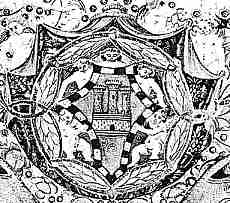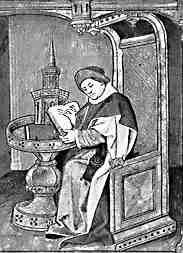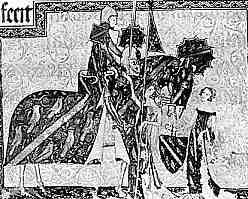

One thing I likid excedingly yn one of the towers, that was a study caullid Paradise, wher was a closet in the midle of 8. squares latisid aboute: and at the toppe of every square was a desk ledgid to set bookes on cofers withyn them, and these semid as yoinid hard to the toppe of the closet: ad yet by pulling one or al wold cum downe, briste highe in rabettes, and serve for deskes to lay bokes on.
From Lucy Toulmin Smith (ed.) 1964 The Itinerary of John Leland in or about the years 1535 - 1543, Carbondale: Southern Illinois University Press, Vol. 1, p.53
From Furnivall, F.J. (ed.) Fifty Earliest English Wills in the Court of Probate, London: AD 1387-1439 Oxford University Press, available online from the University of Michigan's Corpus of Middle English Prose and Verse.
Lady Alice West, 1395, to her son Thomas "a peyre Matyns bookis" and to her daughter-in-law Iohane "a masse booke and all the bokes that I have of latyn, englisch, and frensch, out-tak the forsayd matins bookis ..."
Lady Peryne Clanbowe, 1422 to her brother " a westment of rede cloth with my massbooke and Chalys" and to her friends Elizabeth Ioye "a booke of Englyssh cleped 'pore caytife'" (according to a footnote, a collection of tracts against abuses in the Romish church, formerly wrongly attributed to John Wycliffe), and to Ionet Okbourn "my sauter helid with blake".
John Credy Esq, landowner and owner of a bakehouse and pubs, 1426 "the chirch of Newton have my masseboke, my portus (a portable breviary), my chaleys, my vestments, and my cruettis".
A note refers to the will of John Branchele, 1420, in which he bequeaths to three separate individuals a Latin copy of Boethius "Consolatione Philosophie", an English copy of the same work, and a copy of the "Talys of Caunterbury", supposedly the earliest reference to a bequest of this work.
And from Tymms, S. (ed.) 1850 Wills and Inventories from the Registers of the Commissary of Bury St. Edmund's and the Archdeacon of Sudbury Camden Society, Book 5
Adam de Stanton, chaplain, 1370, had included in his inventory a portifiorum ( a type of antiphoner), a book of law of land, a pair of statutes and a book of romances.
William Place, priest, 1504, bequeathed to the monastery of Saint Edmund "my book of the dowts of Holy Scripture" (a book of Biblical questions formerly ascribed to St Augustine) and to Raff Stanton, priest "my book of the exposicons of Holy Scryptur"
John King, schoolmaster, 1552, bequeathed to his school copies of Pliny, Virgil, Oratius and Ovid with commentaries, and to Mr Sterman, the ecclesiastical histories of Eusebius.
Gilys Levyt, 1552, bequeathed to his daughter "too great books, the Bybyll and the New Testament, with the booke of the Kings Statuts".
As a random sample, there are some things you might expect and some interesting questions to ponder. The priests with their liturgical books and the schoolmaster with his Latin Classics are perhaps not surprising. Lay people also had liturgical and other religious books, along with certain religious paraphernalia, presumably for when the chaplain said mass in their house. Lady Alice is interesting, bequeathing her multilingual literary interests to a female relative and a mass book to her son. Perhaps she thought his soul needed saving. Lady Peryne bequeaths her religious books, but presumably specifies her Wycliffite Lollard text to a girlfriend who can be trusted. (I think there is a novel appearing out of this). This is only a taster, but it suggests a line of inquiry.
Then there is a whole issue of looking at types of books which were specifically produced for a lay market.
If you are looking at this page without frames, there is more information about medieval writing to be found by going to the home page (framed) or the site map (no frames).
